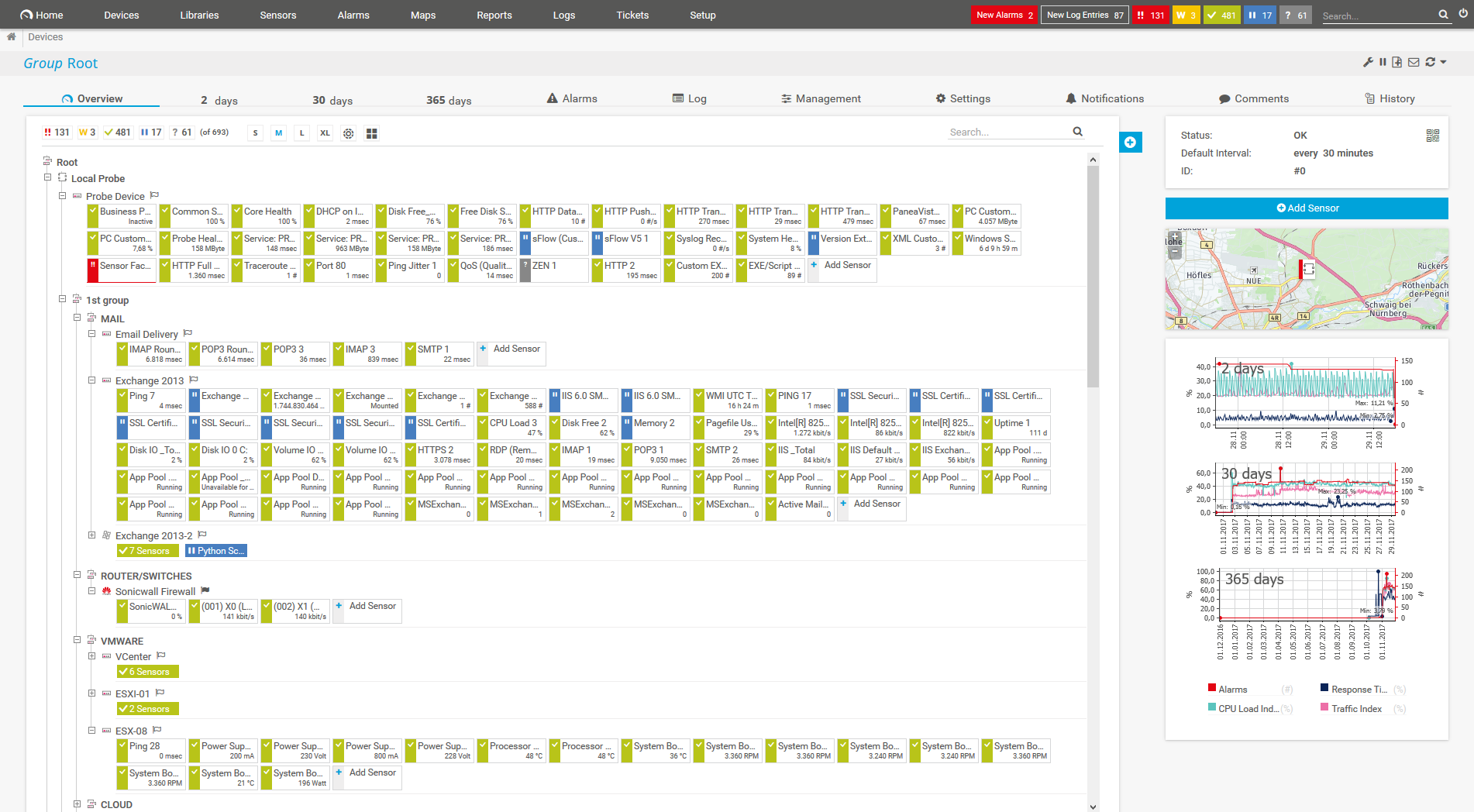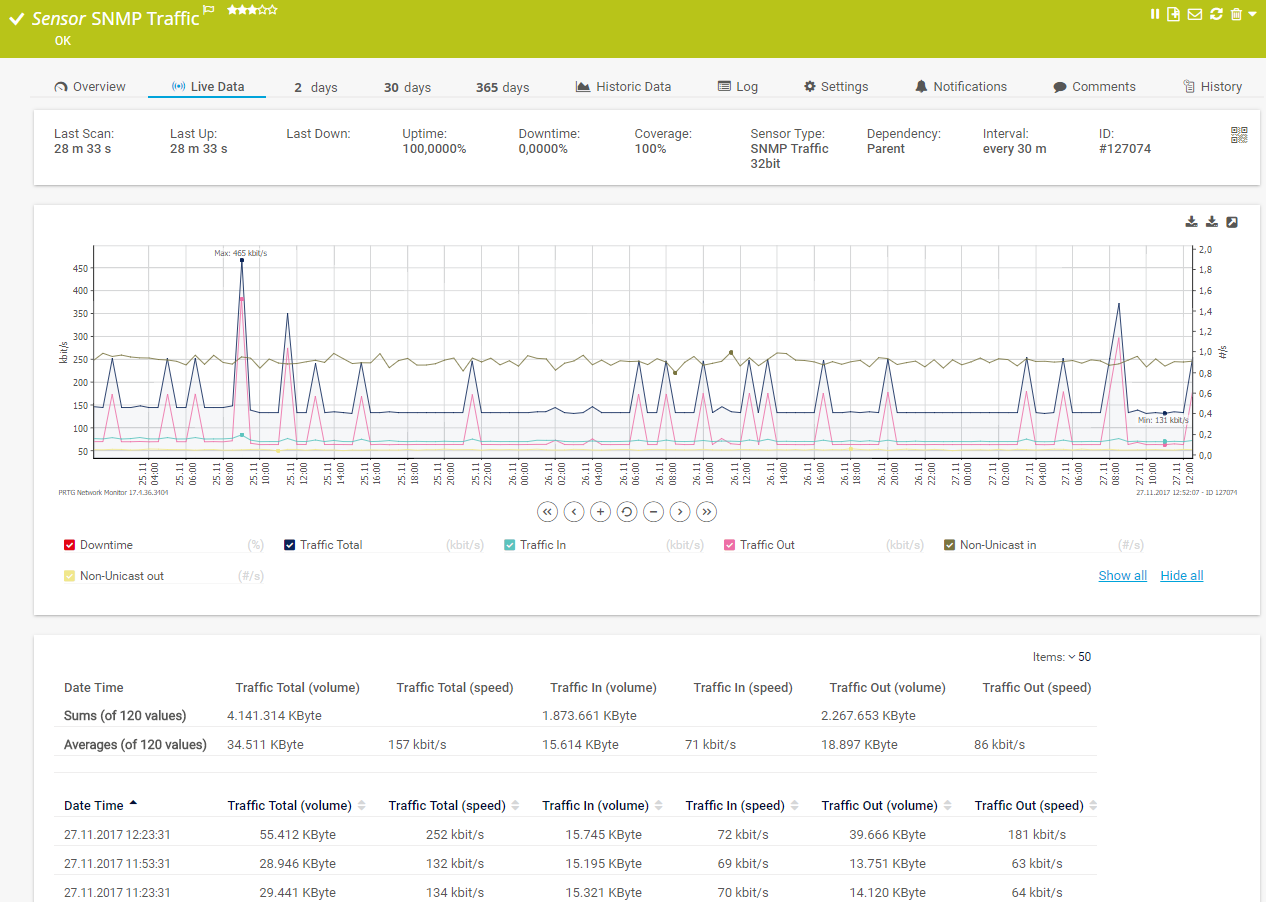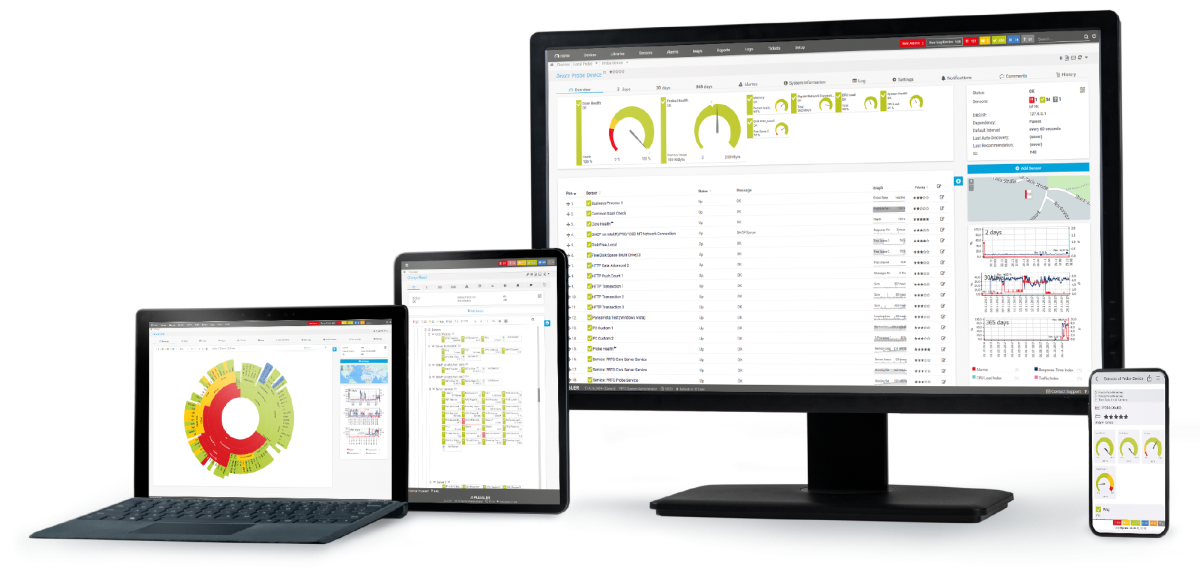Custom alerts and data visualization let you quickly identify and prevent server downtime and unauthorized changes to sensitive files.
The file server is the “heart” of a corporate network, so it’s vital to use Paessler PRTG for 24/7 monitoring to safeguard your systems.
PRTG file server monitoring keeps an eye on system file activity so you can immediately see if changes (desired or undesired) take place. And if your file server is connected to the internet, PRTG helps eliminate data security flaws and prevent external and ransomware attacks.
PRTG helps ensure your FTP servers can always make data available to your customers and employees. If these servers are slow or unavailable, they can disrupt work processes and irritate customers, and even put meeting your service level agreements (SLA) at risk.
PRTG solves for this by helping you make sure your FTP-based services are always up and running, and performing at their best.
If a file server goes down, your coworkers can no longer work and the support desk is flooded with tickets. You can, however, prevent servers from slowing down or crashing and causing major problems – with just one monitoring software.
PRTG empowers you to react immediately to disruptions and unusual user activity to prevent errors from stopping productivity. By proactively monitoring your file server and critical files, we’ll save your company in more ways than one.
Diagnose network issues by continuously tracking the health, availability, and performance of your file server. Show bandwidth usage, network traffic, file access, storage space, modifications to specific files, and other key metrics in real time. Visualize monitoring data in clear graphs and dashboards to identify problems more easily. Gain the overview you need to troubleshoot Windows file servers, NetApp servers, and more.

Device tree view of the complete monitoring setup

Custom PRTG dashboard for keeping an eye on the entire IT infrastructure

Live traffic data graph in PRTG
PRTG is easy enough for beginners but also customizable with features for advanced users. Install it with just a few clicks and let the automatic network discovery create the starting point for your monitoring setup, then fine-tune it according to your needs.
What’s more: With PRTG, you get to define how and when you are informed of disruptions or changes based on custom thresholds and using notification methods such as SMS or email.
With our comprehensive network monitoring software, you can keep a constant eye on your company’s file server. A quick glance at the central dashboard is all it takes to check the server’s status, as well as the health of the entire company network.
PRTG file server sensors show you the last time a modification was made to a file or folder. You can also track whether specific words were written to files, and if so, be notified immediately.
PRTG saves you time and money by helping prevent major issues. Of course we know that every system administrator wants to prevent errors and disruptions before they arise. To do so, you must ensure file integrity and that applications are running properly.
File server monitoring with PRTG makes this possible. If an application causes an issue, PRTG logs the error in an event log file and sounds the alarm so you can fix the error before it becomes serious.
PRTG makes workplaces more reliable and efficient by preventing crashes. Smooth-running business processes are extremely important to your coworkers – but when coupled with data from your FTP servers, these processes also become vital to your customers.
Our preconfigured FTP and SFTP sensors allow for the professional and proactive monitoring of your FTP server and help you ensure your applications and data are deployed securely and efficiently.
PRTG comes with more than 250 native sensor types for monitoring your entire on-premises, cloud, and hybrid cloud environment out of the box. Check out some examples below!
See the PRTG Manual for a list of all available sensor types.
Custom alerts and data visualization let you quickly identify and prevent server downtime and unauthorized changes to sensitive files.
PRTG is set up in a matter of minutes and can be used on a wide variety of mobile devices.

Partnering with innovative IT vendors, Paessler unleashes synergies to create
new and additional benefits for joined customers.
IT that works constitutes a business-critical basis for a company's success. Availability and security must be defined for the respective purpose and closely monitored – by OT and IT alike.
Integrating monitoring results from PRTG into NetBrain maps makes the foundation for network automation.
With ScriptRunner Paessler integrates a powerful event automation platform into PRTG Network Monitor.
Real-time notifications mean faster troubleshooting so that you can act before more serious issues occur.
Network Monitoring Software – Version 25.3.110.1313 (August 27, 2025)
Download for Windows and cloud-based version PRTG Hosted Monitor available
English, German, Spanish, French, Portuguese, Dutch, Russian, Japanese, and Simplified Chinese
Network devices, bandwidth, servers, applications, virtual environments, remote systems, IoT, and more
Choose the PRTG Network Monitor subscription that's best for you
A file server is a computer that stores the file system and all the relevant files of an IT infrastructure or company. This centralized storage allows employees to access files from a variety of different devices. It also allows teams to work on files simultaneously. Access rights are controlled by way of file permissions or directly via the server. In addition to a local network, file servers can also be connected to the internet, where companies may provide data, drivers, applications, and software updates for customers to download.
File server monitoring is the process of tracking and overseeing the performance, security, and accessibility of file servers in a network. A file server is a computer responsible for storing and managing files shared among users or systems on a network. Monitoring a file server ensures that the server operates efficiently, remains secure, and provides reliable access to stored data. This includes:
In today’s world, digital files are required for nearly every business process. Companies have much to gain by using a centralized server to manage their files. A file server allows all employees to work with the same files. This makes access rights and teamwork simpler, more transparent, and easier to manage. In addition, file servers facilitate backups and make it possible to do away with duplicates and outdated versions of files. At larger companies with complex access rights, servers are vital for ensuring work processes remain efficient.
In short, the file server is the “heart” of a corporate network and should therefore be monitored accordingly. Above all, you'll want to keep a constant eye on important system files so you can immediately see if changes (desired or undesired) take place there. And if your file server is connected to the internet, you’ll need to set up permanent and effective monitoring to eliminate security flaws and prevent external attacks.
The key difference between a file server and an FTP server lies in their functionality and the way they handle file sharing:
File server
A file server is a system designed to store, manage, and share files across a network (typically a local area network or LAN). It allows users to access, modify, and share files as if they were on their own computer. Users typically access a file server via a file-sharing protocol like SMB (Server Message Block) on Windows or NFS (Network File System) on Unix/Linux systems. It often integrates with the operating system, allowing for seamless access to files and directories. File servers are commonly used in office networks or organizations where multiple users need access to shared resources like documents, spreadsheets, or databases.
FTP server (File Transfer Protocol server)
An FTP server is specifically designed for transferring files between systems over a network, including the internet. Its main function is to facilitate uploading and downloading files rather than continuous shared access. Access to an FTP server is done via the FTP protocol (or its secure variant, FTPS or SFTP) using FTP clients, web browsers, or command-line tools. It typically requires login credentials, although anonymous access can be enabled. FTP servers are often used to transfer large files over long distances, for website management, or to share files over the internet between different systems or users.
In PRTG, “sensors” are the basic monitoring elements. One sensor usually monitors one measured value in your network, for example the traffic of a switch port, the CPU load of a server, or the free space on a disk drive. On average, you need about 5-10 sensors per device or one sensor per switch port.
Paessler conducted trials in over 600 IT departments worldwide to tune its network monitoring software closer to the needs of sysadmins. The result of the survey: over 95% of the participants would recommend PRTG – or already have.
Paessler PRTG is used by companies of all sizes. Sysadmins love PRTG because it makes their job a whole lot easier.
Bandwidth, servers, virtual environments, websites, VoIP services – PRTG keeps an eye on your entire network.
Everyone has different monitoring needs. That’s why we let you try PRTG for free.